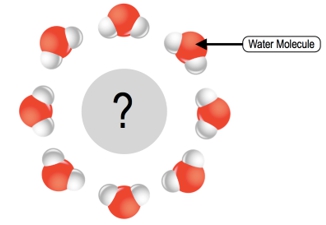In this video, we're going to continue to talk about the properties of water, specifically how water serves as the universal solvent. Water is described as the universal solvent because it is capable of dissolving so many different types of solutes. We need to differentiate the term "solvent" from the term "solutes," and that's exactly what we're going to do below.
The solvent can be defined as the substance that does the dissolving; it is the substance that is dissolving another substance and is usually found in larger amounts and is typically a liquid. In biological systems that consider life, water is usually the solvent. If you are not sure, just go with water being the solvent, especially in this course. This is another reason why water is known as the universal solvent.
The term "solute," on the other hand, can be defined as the substance that gets dissolved by the solvent and is usually found in smaller amounts. To better understand the distinction between solvent and solute, let's look at our example image, which shows table salt (sodium chloride, NaCl) dissolving in water. Notice in the image on the left, we show a salt shaker with table salt, and on the right, we demonstrate the addition of table salt to a cup of water.
Zooming into the salt shaker, we already know from our previous lessons about ionic bonds that sodium chloride consists of a sodium cation (positively charged) forming an ionic bond with a chloride anion (negatively charged). The intact ionic bond is visually represented by a yellow, highlighted dotted line. When we add this table salt to water, it can dissolve because water, being the liquid, serves as the solvent while the sodium chloride becomes the solute.
Upon adding sodium chloride to the water, you'll notice that the ionic bonds have been disrupted; there are no ionic bonds forming between these ions. On the left, we have the sodium cation, and on the right, the chloride anion, both being surrounded by water molecules that have disrupted the ionic bonds. These disruptions allow us to say that the table salt has been dissolved.
Considering the combination of the solute (sodium chloride) and the solvent (water), we refer to this as a solution. The solution is the combination of both the solute and the solvent. This forms an aqueous solution, a term that refers to a solution where water is serving as the solvent. In biological systems that consider life, water typically serves as the solvent, and such systems often utilize aqueous solutions.
You may have noticed that the water molecules form what is known as a hydration shell around each of the solute ions being dissolved. The hydration shell is simply a layer of water molecules surrounding each ion. Water's ability to dissolve many different types of solutes, such as proteins, nucleic acids, and carbohydrates, justifies its title as a universal solvent, even though it cannot dissolve everything. This concludes our brief introduction to water as the universal solvent and distinguishing the terms solvent, solute, and solution. We'll get some practice applying this knowledge as we move forward. I'll see you all in our next video.


